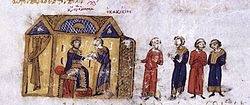Gagik II of Armenia
Monday, April 25, 2022
Gagik II (c. 1025 - May 5/November 24, 1079) was the last Armenian king of the Bagratuni dynasty. Known as Gagik II King of Ani (Ani being the capital of the kingdom at the time), a juvenile at the time, he was enthroned as Gagik II and ruled for a brief period from 1042 to 1045 before the Bagratid dynasty rule collapsed in Armenia.
During the reign of Hovhannes-Smbat (John-Smbat), a feudal lord, David, who owned Taik during his battles against the Muslims, gained a large area which stretched all the way to Manzikert. David was a subject of Byzantium and when he died his entire territory was occupied by Basil II, who had resumed the policy of, bit by bit, annexing Armenia to his empire.
This policy of occupation and expansion was also pursued by the successors of Basil II. By the death of Hovhannes-Smbat around 1040 and that of Ashot IV shortly after, Michael V, one of the successors of Basil II, was the emperor cornering Armenia. Michael claimed that the Kingdom of Ani by virtue of the will of Hovhannes-Smbat, was bequeathed to the Byzantine Empire upon his death.
When the Armenian sparapet, Vahram Pahlavuni, prepared the coronation of the successor to Hovhannes-Smbat, the king's nephew, Gagik II, who at that time was only fourteen years old, the Byzantine emperor began supporting vestes Sargis Haykazn, a pro-Byzantine Armenian prince and minister of the former king, who had initially been appointed regent. After this the kingdom of Ani resisted three assaults of the Byzantine Empire, forcing them to retreat. Byzantium exerted its forces to the utmost in order to conquer Armenia and once and for all annexing it to the empire. To this end, they sent a great army to the southern part of Armenia and at the same time convinced the king of Tashir-Dzoraget to attack Ani from the east. At the fierce battle that was fought by the walls of Ani, general Vahram Pahlavuni heavily defeated the Byzantine army, forcing them to leave 20,000 dead behind, according to contemporary Armenian chroniclers. This victory allowed Vahram Pahlavuni along with Catholicos Petros I Getadardz to crown Gagik II king of Armenia and subsequently take the fortress of Ani, which was in the hands of Vest Sargis. Sargis fled to the fortress of St. Mary and was eventually captured.
After this victory, the new Armenian king, together with Vahram, turned toward their second enemy, the Seljuq Turks, who were still intent on conquering the kingdom. In the following two years Gagik reinforced the army and fought against Seljuq hordes. Gregory Pahlavuni nephew of Vahram, defended the fortress of Bjni. The Armenian army hurried to confront the enemy at the location of the present-day Lake Sevan, where the king and his commander split the Armenian army into two units. The first division engaged in a battle with the Seljuq Turks and then pretended to retreat, drawing the Turks in pursuit toward the second army that was lying in ambush. The battle ended with a catastrophic defeat for the Seljuq Turks. In the Kingdom of Vaspurakan, formerly under the protection of the Byzantine Empire where the population had been deserted by the imperial army, the people eagerly anticipated the Armenian king would be driving the Seljuq Turks out of their homeland. Under leadership of Gagik II, known for his courage as "the Lion," the Armenians revolted and the Turks were forced to retreat to Khoy and Salmas.
Vahram began negotiations with the new Byzantine emperor Constantine IX Monomachus. Gagik II offered to be a vassal of the emperor, but the Byzantines did not accept it and prepared a new expedition entrusted to the Duke of Iberia, Michael Iasites, but he failed in the face of Armenian resistance. Emperor Constantine wished to continue the policy of his predecessors and therefore sent an army to conquer Armenia, whilst inciting the Kurdish emir of Dvin, Abu'l-Aswar, to attack Armenia from the east. King Gagik II, however, managed to placate Abu'l-Aswar by sending him gifts. This allowed Gagik to concentrate his forces against the Byzantines, eventually forcing them to flee. Gagik II proved his worth for the throne and the reputation of a fighting king, which had passed on to him from the very first kings in the Bagratuni dynasty. The Byzantines soon realized that if Armenia could not be conquered by force, it could be taken by treachery. Gagik pardoned Vest Sargis, whose loyalties, however, remained with Byzantium, fostering the hope of being appointed as king of Armenia if Byzantium was to conquer Armenia. With the assistance of Vest Sargis, the Byzantine emperor invited Gagik II to Constantinople to sign an allegedly permanent peace-treaty. Gagik II was invited to visit Constantinople. There the emperor demanded that the Armenian king abdicate and hand over the throne to him, and as he refused to do so was thrown into jail. The Byzantines promptly sent an army to Armenia, which was now leaderless.
In lieu of its rightful king, Armenians considered offering the throne of Ani to David I Anhoghin of Lori or to the emir of Dvin, Abu'l-Aswar, married to the sister of David Anhoghin. Even Bagrat IV of Georgia was considered but surprisingly not the Bagratuni King Gagik-Abas of Kars. The patriarch Petros did not approve of any of the three candidates and finally conceded the delivery to the Byzantines of the city of Ani and other fortresses. With his connivance, the Byzantines were finally able to occupy Ani in 1045. The country was incorporated into the empire.





